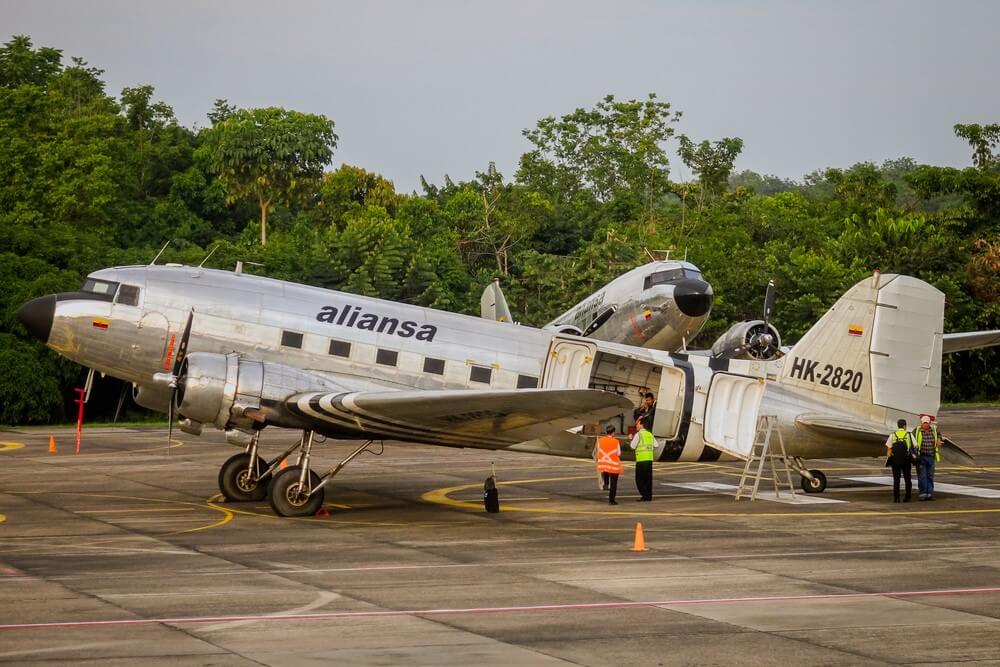On July 8, 2021, a Douglas DC-3 registered as HK-2820 of Aliansa went missing in Colombia. The aircraft disappeared from radars five minutes after taking off for a training flight and, reportedly, was found in a riverbed.
Yes, the DC-3 is a WW2-vintage aircraft. In fact, the crashed one was built either in 1943 or 1944 (depending on the source) and may have very well participated in the closing actions of the war, before being sold off by the US Air Force in the 50s.
Some might remember that in 2019 Colombia already had a prominent incident involving a DC-3 – an aircraft, built in 1945 crashed killing 14 people. Later that year, the same DC-3 of Aliansa was damaged in a runway excursion. In total, according to the Aviation Safety Network, the country had eight accidents involving the type in the last decade, not including the ones that remained unreported.
How come Colombia has so many accidents involving vintage aircraft?
Airliner-sized bush plane
The reason, obviously, is that Colombia has a lot of these vintage aircraft. Before July 8th, Aliansa alone operated four of them, not including three more that crashed since the airline commenced operations in 1995. According to Steve Hide – a journalist who had a chance to experience the Colombian DC-3 culture a few years ago – it is virtually impossible to establish how many aircraft of this type are operated in the country. By any estimate, it is dozens.
The DC-3 itself is quite definitely the only war-time aircraft that is flown around the world in a significant number. According to the DC-3 Appreciation Society – because such a group obviously exists – there were 172 aircraft of this type in active operation in mid-2020. The number of airworthy examples is estimated at over 600, although it is impossible to say for sure.
A part of this number belongs to enthusiasts (mostly in the US and Canada) who operate the aircraft as a historic piece, flying them at airshows and trying to preserve an important part of aviation history. But another significant part is commercial operators: companies, such as Aliansa, fly them because, well, there is no alternative.

A turboprop-converted DC-3 belonging to Colombian police. Private companies are not the only ones operating this aircraft; in fact, just hours after the DC-3 crash on July 8, a Colombian Air Force DC-3 was circling in the region, possibly as a part of the search effort. (Image: Markus Mainka / Shutterstock)
The aircraft has a number of crucial advantages that are well known to anybody who ever came in contact with it. It is sturdy and reliable; it is easy and not too expensive to fly; it is simple to maintain and, thanks to the fact that a lot of them were manufactured, there is a steady stream of spare parts – even though the production stopped in 1950. It also can land on short and unprepared runways, basically being a bush plane in an airliner form.
A result of that is a sort of “DC-3 culture” that formed around the aircraft in countries that are in dire need of connecting geographically distant population centers through the air, mostly in South America. Colombia is a hotspot of that culture. In 2018, Al Jazeera filmed a short documentary about it, highlighting the romanticism and above all – the danger of flying vintage planes in tropical conditions of the country.
DC-3 – a departing legend
The underside of such dangerous operations is the high toll they take. With the latest crash, more than half of Aliansa’s fleet have already perished in fatal accidents in the span of two-and-a-half decades.
There is a well-known saying among the enthusiasts of the plane – “the only replacement for a DC-3 is another DC-3”, as, supposedly, no other aircraft can take on the job. Outskirts of small Colombian airports usually house several non-operational DC-3s with the explicit purpose of being cannibalized. Nevertheless, at that rate, the country is going to run out of the type sooner or later.
To be fair, retirement is a thing that does not really apply to the DC-3 – most of the operating aircraft of this type have already been retired at one point or another, only to be sold off and proceed with operations. Nevertheless, as no new DC-3s have been manufactured in over seven decades and the existing ones do not multiply, from time to the tragic time they have to be replaced by something.
It appears old Antonovs – mostly the An-24 and its derivatives – are pretty much the only ones that can take on the role. The ex-Soviet planes have already established their reputation in Africa, proving to be reliable, simple to maintain, and well-suited to extreme climates.
It is only a question of time before the Colombian routes operated by DC-3s from the 40s will be replaced by Antonovs from the 60s and 70s. A small upgrade, but an interesting – and unprecedented one – indeed.

